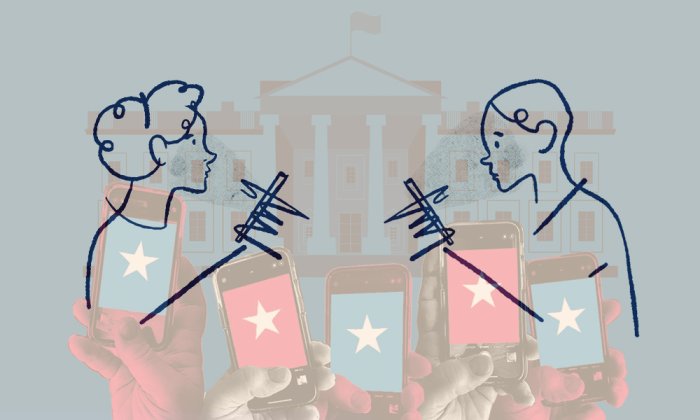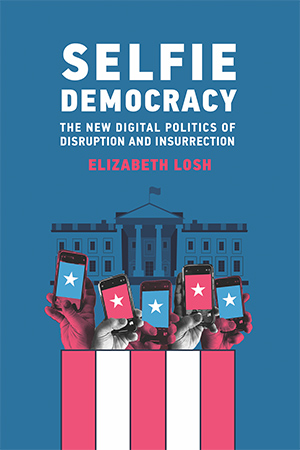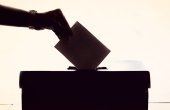Is Digital Media Undermining Citizenship?

Smartphones and other digital devices seem to give us a direct line to politicians. But is interacting with presidential tweets really a manifestation of digital democracy? In her new book “Selfie Democracy,” media theorist and digital rhetoric scholar Elizabeth Losh exposes the unintended consequences of wireless technologies on political leadership and shows how seemingly benign mobile devices that hold out the promise of direct democracy undermine representative forms of government. “Masked by the appeal of greater direct democracy,” she argues in the book’s introduction, “both tech companies and authoritarian figures have amassed power largely through image management and opinion framing rather than through a true broadening of civic life.”

Drawing on archival research, extensive interviews with insiders at the White House, State Department, and the Trump Organization, and a trove of digital data, Losh explains that politicians who use digital media appeal to the same fantasies of digital connection, access, and participation peddled by Silicon Valley. The “disruption” promoted by tech companies to existing economic and social institutions inevitably destabilizes our political frameworks as well. Meanwhile, Losh argues, smartphones and social media don’t enable participatory democracy so much as they incentivize citizens to perform attention-getting acts of political expression.
The Editors: What is the significance of the selfie as it relates to democracy?
Elizabeth Losh: A selfie is a kind of identity performance that also demonstrates one’s connection to other people (through social media) and to technology (which records the event). Although selfies are often dismissed as signs of narcissism or egotism, they can establish membership in a community and perform important political work. One can mark oneself as present at a particular place and time, whether it be a campaign rally or a protest. Those excluded from society can also use selfies to assert their right to be seen in public. For example, both disabled and transgender people have used selfies to challenge stereotypes about where they belong.
Selfies have also been embraced by the political establishment. Candidates take selfies with their constituents, just like they shake hands and kiss babies. The problem with connecting with our elected representatives in this way, which is designed around social media, is that it propagates a fantasy of direct connection that can undermine investments in representative government.
The Editors: You interviewed several insiders at the White House, State Department, and the Trump Organization. Who were some of the key individuals you spoke with, and what were your most unexpected findings?
Elizabeth Losh: I spoke with those in charge of digital strategy for Obama — both in his campaign and in the White House — and those who consulted with Hillary Clinton on digital strategy in her campaign and in her time at the State Department. I also interviewed people lower in the organizational hierarchy, such as contract workers and interns. I was impressed with how frank my subjects were about the failures they had witnessed, and I was often struck by the insightfulness of their comments as they looked back at their own past illusions about digital direct democracy.
Although people from the Trump Organization seemed much less willing to talk to me, persistence reaching out to Republicans sometimes paid off. I was particularly grateful to Jane Cook, who created the WhiteHouse.gov website for George W. Bush. She shared her experiences handling the flood of visitors seeking information after September 11. Cook recalled intense discussions about protecting user privacy in particular. “We discussed using cookies on WhiteHouse.gov in 2001 because we wanted to know more about the users of WhiteHouse.gov so we could make the site better,” she explained to me in an email. “However some people were suspicious of sites that used cookies, particularly government websites at the time. People feared that ‘big brother’ was spying on them.” Although Bush’s White House expanded its online information-gathering efforts after the September 11 attacks, the anti-cookie policy remained in place until it was dismantled by the Obama administration — not without considerable pushback.
The Editors: At some point you interviewed Peter Costanzo, the publicist who in 2009 explained social media to Donald Trump and taught him how to tweet. What can you say about that meeting?
Elizabeth Losh: Costanzo shared many stories that I hadn’t read anywhere else. His account of his initial meeting with Trump and the fact that he only had seven minutes to explain social media is one that has appeared in the media before. (Ultimately it lasted closer to 20.) However, in my interview with him, Costanzo revealed a lot more about Trump’s motivations and attitudes about using digital media for self-promotion and about how Trump was directly enabled by social media companies.
Facebook’s handover of 200,000 users to Trump was one of the truly extraordinary pieces of luck from which Trump benefited to stage his internet breakout.
“I was showing him the impostor, what the impostor was doing, and I told him that I had already reached out to Facebook,” Costanzo told me, referring to an impostor account that was drawing thousands of Trump’s potential fans to counterfeit Twitter and Facebook accounts. “I alerted them that if he was definitely willing to do this that I could have this remedied. They would switch the 200,000 followers to his new Facebook page automatically. Those fans would have no idea that there was this actual change.”
Facebook’s willingness to give those 200,000 unearned followers to Trump was an extraordinary windfall for his social media ambitions. It is important to remember that this was a relatively prestigious follower count at the time; scrambles among celebrities to top the million mark were not yet underway. This handover was one of the truly extraordinary pieces of luck from which Trump benefited to stage his internet breakout.
The Editors: Obviously, Barack Obama and Donald Trump have little in common when it comes to their ideologies and moral visions, but in the book you argue that they actually employed the same rhetorical themes. You identify four specifically — what you call the rhetorics of connection, transparency, participation, and access. Can you briefly explain these rhetorics?
Elizabeth Losh: Both Trump and Obama used digital media to enhance their popularity and to make themselves more relatable to their supporters. Obama emphasized connection with potential voters by giving them their own social media platform at BarackObama.com. Trump used the design features of existing social media platforms — by retweeting or using emoji — to connect to his fans. Obama established his image as a change agent by promoting transparency (although he wasn’t the first president to exploit this theme) and encouraged his followers to do their own research on government websites, which were going to have lots and lots of data available. As Trump peddled conspiracy theories, he also trumpeted transparency themes, and his enablers urged people to research subjects independently on the web. Using everything from YouTube fireside chats to virtual reality tours, Obama promised that citizens would be able to have more access to the president and his administration. By courting social media influencers, Trump also dangled access. Obama pledged that citizens would benefit from more two-way participation in their government. Online town halls and petitions were designed to encourage deeper involvement. Before attacking the Capitol on January 6, 2021, Trump’s supporters were also exhorted to participate. These four rhetorical themes also focused on getting rid of the intermediaries that separated a political leader from his people.
The Editors: There’s a subchapter in your book on We the People, a now-defunct section of the WhiteHouse.gov site devoted to online petitions. You describe it as “one of the signature digital direct democracy projects of the Obama administration.” However, the petitions largely became symbolic and ultimately took a turn for the absurd before Trump terminated the project. What lessons about online political participation can be learned from this crowdsourcing experiment?
Elizabeth Losh: One key rule of life on the internet is to “never feed the trolls.” But politicians really can’t avoid feeding trolls in an extremely politically polarized society in which users look for every advantage or opportunity to humiliate their opponents. In the beginning, We the People had noble ideals to allow average people to organize and affect policy by making their voices heard. It was also a public relations tool. By the time the plug was pulled on the site, the most popular petitions were devoted to snark, satire, conspiracy theories, or vitriol.
It ultimately wasn’t about giving us access to the powerful; it was about giving the powerful access to us.
Although White House staff who maintained the site day-to-day had to manage insincere trolls and deluded conspiracy theorists, the energy and size of the site’s broader audience imbued their labor with an invigorating sense of meaning. As Tom Cochran, Obama’s director of new media technologies, argued, the platform “inspired a crowdsourced mentality that galvanized people around good ideas” and “streamlined the process for bringing attention to critical issues.” Certainly, such crowdsourcing is problematic in many ways. It tends to privilege people with digital literacy, technical resources, superior status in the dominant culture, and access to means of amplification via social media platforms. Nonetheless, crowdsourcing as a force for shaping economic, cultural, and political production is not going away anytime soon. The Obama administration’s encounter with such a wide variety of crowdsourced efforts merits further attention, and an entire book could easily be written about its case studies.
The Editors: The Obama administration invited citizens to share in the power and privilege of the White House — the Google Street View project, Obama’s weekly video addresses, and his summer playlists are just a few examples of what you call his rhetoric of access. This was, you note, a key component of the White House’s digital strategy. Is there anything about this kind of access that we should be wary of?
Elizabeth Losh: Establishing rapport or intimacy by being more accessible online isn’t necessarily a bad thing. The problem comes from accepting this kind of superficial digital access as a substitute for having a more substantive role in the political process and actual deliberations on policy. Unfortunately, the Obama administration did little to discourage tech companies from accumulating power, because it was a mutually beneficial arrangement not to regulate them. Now citizens have their opinions shaped 24/7 by these companies — thanks to ubiquitous computing on “smart” phones and in “smart” homes. In other words, it ultimately wasn’t about giving us access to the powerful; it was about giving the powerful access to us.
The Editors: Your chapter on the Trump administration’s rhetoric of transparency looks at the authentication of conspiracy theories like Pizzagate and the new face of “fake news.” How did Trump give the illusion of transparency?
Elizabeth Losh: Trump didn’t directly connect himself to Pizzagate (although he definitely benefitted from its successor and close relative QAnon), but I use Pizzagate as a way to understand how Trump used other “gate” conspiracy theories to mobilize his supporters and how he weaponized fake news more generally by constantly calling for more transparency. Hacktivist organizations supposedly founded for transparency, such as Wikileaks, were important enablers, but other nonhierarchical knowledge networks like Wikipedia also played a role.
The Editors: You write that after looking closely at the digital documents in Pizzagate’s “constellation of fictions,” you believe there is more to the story than deranged internet conspiracy thinking that can be easily dismissed. Can you explain?
Elizabeth Losh: Although their findings may be factually untrue, people who believe in conspiracy theories are rarely dissuaded by the corrective approach, in which lies are supposed to be rebutted with truth. This is because people feel that they gain emotional and practical support by being part of a knowledge-sharing community. Although it might seem counterintuitive, these communities often feel that they have lots of checks and balances in place to avoid propagating misinformation. When you actually look at hundreds of postings, what you see is lots of explanation, vetting, deliberation, and debate (alongside lots of memes, of course). They see themselves as gatekeepers — even if they also complain about gatekeepers. The problem is that the internet rewards authorization rather than authority, authentication rather than authenticity, verification rather than veracity. In other words, algorithms are distorting the whole human knowledge system.
The Editors: Looking forward now, how do you see the Biden administration engaging in digital democracy? What might we be on the lookout for as the 2024 election cycle approaches?
Elizabeth Losh: I thought Biden was smart not to lean into the technology that Obama embraced so uncritically. Key Trump voters in the rustbelt and rural areas were repelled by the idea that the economy would be run by tech workers, algorithms, and robots. Those who didn’t accept the results of the 2020 elections still feel that way: They blame electronic voting machines and smart home thermostats for nullifying their votes.
My book argues that identity politics will continue to be important in determining who controls the American government and that attitudes about race, gender, and class are deeply connected with attitudes about technology. If we have choices other than Trump and Biden in the next race, that’s what I will be looking for. After all, Obama promoted himself as representing a particular kind of postracial masculinity, and he did so in his performances with technology that were documented by his very skilled and social media savvy photographer Pete Souza. Hillary Clinton’s campaign was doomed not only because of her use of technology or because she was a woman, but because of attitudes about digital privacy that were deeply gendered. How candidates work with their repertoire of digital platforms and practices will still depend on their gender, race, and class.


